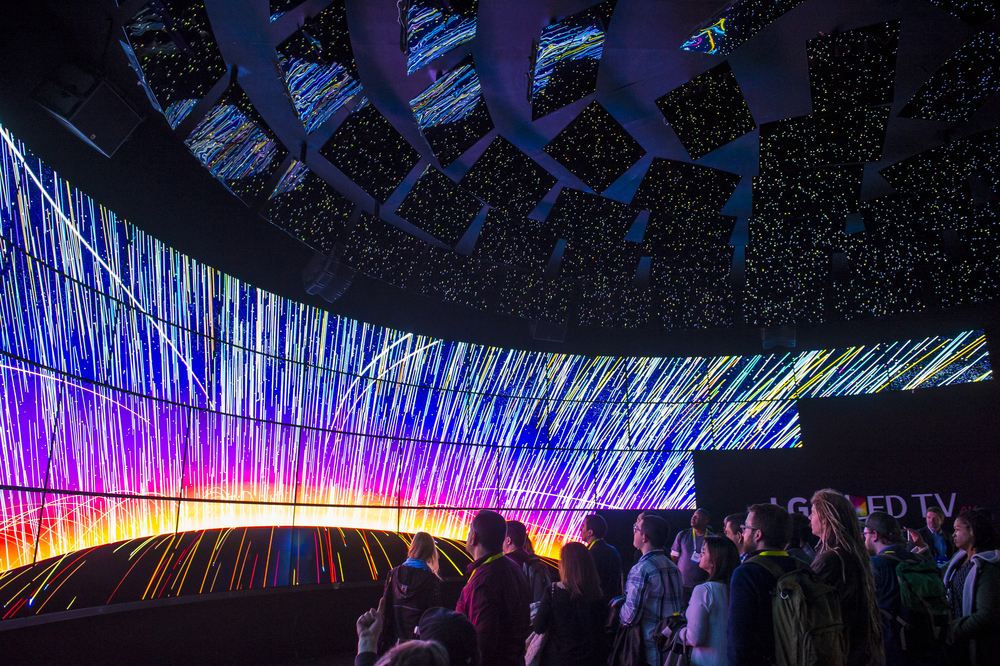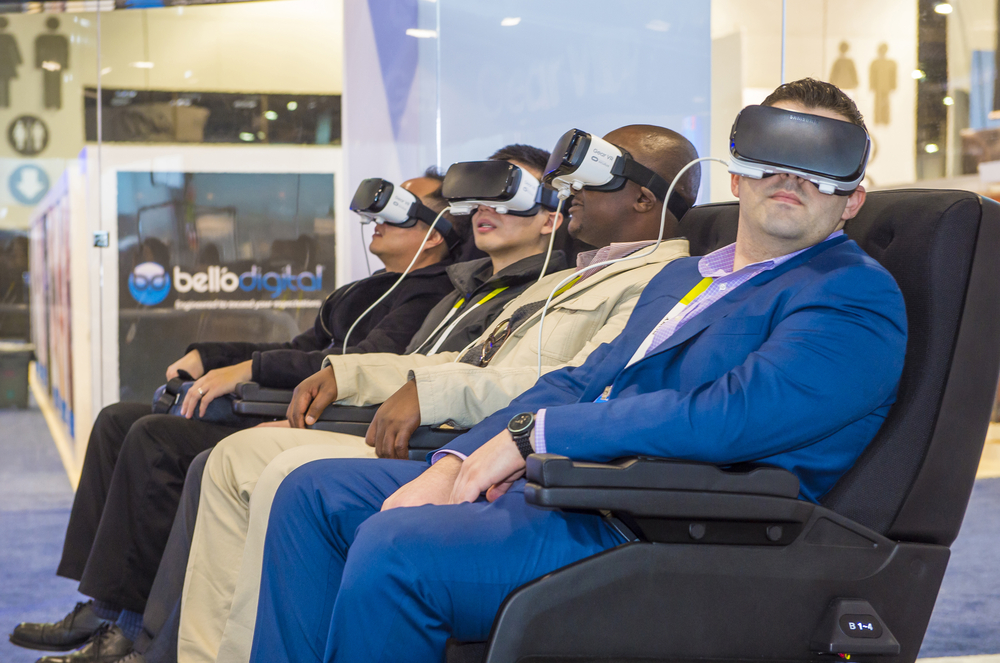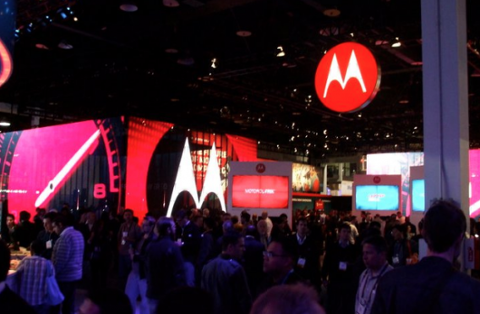[caption id="attachment_139045" align="aligncenter" width="1000"]

LG's CES booth[/caption] The Consumer Electronics Show (CES) takes place this week in Las Vegas. The event is typically viewed as the kick-off for a new year of gadgets and technological advancements. Unfortunately, that thinking is viewed by many as outdated, and the show risks vacuuming up the resources of companies involved in it. Over the past few years, CES has become more of a venue for deals to be made between companies than the true ‘consumer’ electronics show suggested by its name. Various executives from disparate tech companies use the show to discuss supply chain and manufacturing as well as the direction they want products to go. Case in point: Google’s strong-arming of Samsung in 2014 to ease up on TouchWiz, or its UI offshoot dubbed ‘Magazine UX.’ As Recode
wrote at the time: “Multiple sources familiar with the companies’ thinking say the two technology giants began hammering out a series of broad agreements at CES that would bring Samsung’s view of Android in line with Google’s own.” The biggest players are also missing from the CES floor. Apple famously derailed the show in 2007 by scheduling its iPhone announcement during CES (how very Steve Jobs!), and it has a
long history of making announcements/seeding rumors during the show to draw attention from Las Vegas. One has to wonder why CES draws such ire from Apple. Similarly, big players such as Google and Microsoft also reserve product or service announcements for other times of the year, further cementing the show's place as an also-ran for those without the synergy to command a standalone event. The show is now dominated by the likes of Sony; while producing great stuff, its announcements often leave you with a feeling of "that’s it?" HP and Lenovo also use CES to dump a slew of PCs, Laptops and monitors on us. Smartphone manufacturers from overseas leverage the show to announce new wares, which is odd considering the press for those events is typically foreign as well, and the devices just don’t sell well stateside. [caption id="attachment_139047" align="aligncenter" width="1000"]

VW's CES concept vehicle[/caption]
Auto Is Taking Over
If you need to find a bright spot within CES, it’s typically across the street. While the Las Vegas Convention Center (LVCC) is full of people running around trying to find neat gadgets, real innovation is showcased by car companies, with some demonstrations taking place outside. As technology goes, it’s still the wild west for big auto. Between smart cars with in-dash assistants like Siri (CarPlay) or
Google (Android Auto) and standalone safety features, automotive now dominates CES. Even if you’re not crazy about the latest things Apple or Google want to do with your car, companies often show off things you definitely should care about. Safety features such as automatic breaking and vehicle awareness are often in-car experiences at CES you can check out (a driver will literally try to drive into a wall and let the car stop itself), and there’s never a shortage of electric vehicles to run around a track. [caption id="attachment_139048" align="aligncenter" width="1000"]

VR demo at CES[/caption]
CES Is Still A Non-Starter for Most
While car companies with deep pockets have resources to dump into splashy booths and experiences, many don’t have the cash or energy to spill into the show – nor do they need to. Booths at CES are expensive, and location matters. Bigger booths get valuable placement, but are only affordable to larger companies. Startups are left to jockey for attention in offshoot halls and corridors, which are often ‘themed’ by CES (drone manufacturers are all pigeonholed into the same general location, for instance). In light of that, finding your footing as a vendor can be tough. In 2015, a startup founder asked my thoughts on renting a CES booth, which his PR consultant recommended. I argued against it, and he decided to get an attendee badge and try to schedule meetings on the fly. After the show, he let me know that he went by the booth CES tried to sell him on, which was deep in an ‘accessories’ hall at LVCC. While his product was an accessory, being surrounded by dime-a-dozen iPhone case manufacturers wouldn’t have captured the essence of his product. That's a sentiment we hear often from startups: the show is just not worth the price of admission. That’s not to say the show is without its bright spots. The best thing to happen to CES in quite some time was SlingTV, which
stole the show in 2015. It has since become a notable TV solution for cord cutters, albeit delivered by Dish Network, which went all-in to promote and advertise it at the show and afterward. This year, Linksys is out of the gate early with an impressive take on
mesh networking for the home; an established name with a robust supply/distribution chain just stomped all over the Eeros of the world. On the software side, GE home appliances now
work with Nest and
Drop to control settings. If you were planning a service to patch that gap in the dreaded Internet of Things (IoT), GE just drop-kicked your startup idea. Speaking of IoT, Norton (yeah, the antivirus company) thinks it can protect your entire home network with a
router that can run malware checks and quarantine affected devices. Those are all big companies further tightening their grip on the consumer technology market at CES, just like the big auto firms. Startups need not apply; CES is a showcase for large companies who can afford to buy their way to prominence on the show floor, not a balanced exhibit of the best tech or services available for consumers.
 LG's CES booth[/caption] The Consumer Electronics Show (CES) takes place this week in Las Vegas. The event is typically viewed as the kick-off for a new year of gadgets and technological advancements. Unfortunately, that thinking is viewed by many as outdated, and the show risks vacuuming up the resources of companies involved in it. Over the past few years, CES has become more of a venue for deals to be made between companies than the true ‘consumer’ electronics show suggested by its name. Various executives from disparate tech companies use the show to discuss supply chain and manufacturing as well as the direction they want products to go. Case in point: Google’s strong-arming of Samsung in 2014 to ease up on TouchWiz, or its UI offshoot dubbed ‘Magazine UX.’ As Recode wrote at the time: “Multiple sources familiar with the companies’ thinking say the two technology giants began hammering out a series of broad agreements at CES that would bring Samsung’s view of Android in line with Google’s own.” The biggest players are also missing from the CES floor. Apple famously derailed the show in 2007 by scheduling its iPhone announcement during CES (how very Steve Jobs!), and it has a long history of making announcements/seeding rumors during the show to draw attention from Las Vegas. One has to wonder why CES draws such ire from Apple. Similarly, big players such as Google and Microsoft also reserve product or service announcements for other times of the year, further cementing the show's place as an also-ran for those without the synergy to command a standalone event. The show is now dominated by the likes of Sony; while producing great stuff, its announcements often leave you with a feeling of "that’s it?" HP and Lenovo also use CES to dump a slew of PCs, Laptops and monitors on us. Smartphone manufacturers from overseas leverage the show to announce new wares, which is odd considering the press for those events is typically foreign as well, and the devices just don’t sell well stateside. [caption id="attachment_139047" align="aligncenter" width="1000"]
LG's CES booth[/caption] The Consumer Electronics Show (CES) takes place this week in Las Vegas. The event is typically viewed as the kick-off for a new year of gadgets and technological advancements. Unfortunately, that thinking is viewed by many as outdated, and the show risks vacuuming up the resources of companies involved in it. Over the past few years, CES has become more of a venue for deals to be made between companies than the true ‘consumer’ electronics show suggested by its name. Various executives from disparate tech companies use the show to discuss supply chain and manufacturing as well as the direction they want products to go. Case in point: Google’s strong-arming of Samsung in 2014 to ease up on TouchWiz, or its UI offshoot dubbed ‘Magazine UX.’ As Recode wrote at the time: “Multiple sources familiar with the companies’ thinking say the two technology giants began hammering out a series of broad agreements at CES that would bring Samsung’s view of Android in line with Google’s own.” The biggest players are also missing from the CES floor. Apple famously derailed the show in 2007 by scheduling its iPhone announcement during CES (how very Steve Jobs!), and it has a long history of making announcements/seeding rumors during the show to draw attention from Las Vegas. One has to wonder why CES draws such ire from Apple. Similarly, big players such as Google and Microsoft also reserve product or service announcements for other times of the year, further cementing the show's place as an also-ran for those without the synergy to command a standalone event. The show is now dominated by the likes of Sony; while producing great stuff, its announcements often leave you with a feeling of "that’s it?" HP and Lenovo also use CES to dump a slew of PCs, Laptops and monitors on us. Smartphone manufacturers from overseas leverage the show to announce new wares, which is odd considering the press for those events is typically foreign as well, and the devices just don’t sell well stateside. [caption id="attachment_139047" align="aligncenter" width="1000"]  VW's CES concept vehicle[/caption]
VW's CES concept vehicle[/caption]
 VR demo at CES[/caption]
VR demo at CES[/caption]


